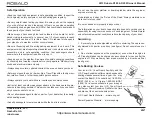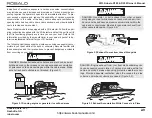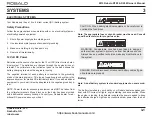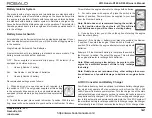
2013 Robalo R180 & R200 Owner’s Manual
Robalo Boats, LLC
Nashville, GA
robalo.com
2-2
Safe Operation
•Keep your boat and equipment in safe operating condition. Inspect the
hull, engine(s), safety equipment, and all boating gear regularly.
•Be very careful when fueling your boat. Be sure you know the capacity
of your boat’s fuel tank and the amount of fuel you use when operating
at frequently used engine speeds (RPMs). Ask your Robalo dealer about
the capacity of your boat’s fuel tank.
•Make sure you have enough fuel and outboard oil on board for antici-
pated cruising requirements. In general, use 1/3 of your supply to reach
your destination and use 1/3 to return. Keep 1/3 in reserve for changes in
your plans due to weather or other circumstances.
•Be sure lifesaving and
fi
re extinguishing equipment is on board. This
equipment must meet regulatory standards and it should be noticeable,
accessible, and in safe operating condition. Your passengers should
know where this equipment is and how to use it.
•Keep an eye on the weather. Be aware of possible changing conditions
by checking local weather reports before your departure. Monitor strong
winds and electrical storms closely.
•Always keep accurate, updated charts of the area on board your boat.
•Before you leave the port or harbor,
fi
le a Travel Plan with a family mem-
ber, relative, friend, or other responsible person ashore.
•Always operate your boat with care, courtesy and common sense.
•Instruct at least one other passenger aboard in the basic operating pro-
cedures in handling your boat. This person can take over if you unexpect-
edly become unable to do so.
•Do not allow passengers to ride on parts of your boat other than desig-
nated seating areas.
•Ask all passengers to remain seated while the boat is in motion.
•Do not use the swim platform or boarding ladder while the engine or
engines are running.
•Understand and obey the “Rules of the Road.” Always maintain com-
plete control of your boat.
•Do not overload or improperly load your boat.
The information on your boat’s capacity plate does not override your re-
sponsibility for using common sense or sound judgment. Turbulent water
and unfavorable weather conditions reduce the capacity of your boat.
Swimming
1. Swim only in areas designated as safe for swimming. These are usu-
ally marked with a swim area buoy (see
fi
gure). Do not swim alone or at
night.
2. Do not allow anyone near the propeller(s), even when the engine is
off. Propeller blades can be sharp and can continue to turn even after the
engine is off. Stay well away from areas marked by a diver down
fl
oat
(see
fi
gure).
Safe Boating Courses
Your local U.S. Coast Guard Auxiliary and the
U.S. Power Squadrons offer comprehensive safe
boating classes several times a year. You may
contact the Boat/U.S. Foundation at 1-800-336-
BOAT (2628), or in Virginia 1-800-245-BOAT
(2628). For a course schedule in your area you
may also contact your local U.S. Coast Guard
Auxiliary or Power Squadron Flotilla for the time
and place of their next scheduled class.
U.S. Coast Guard Website: www.uscg.mil
Power Squadron Website: www.usps.org
https://www.boat-manuals.com/
















































